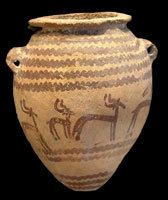 | ||
The Naqada culture is an archaeological culture of Chalcolithic Predynastic Egypt (ca. 4400–3000 BC), named for the town of Naqada, Qena Governorate. A 2013 Oxford University radio carbon dating study of the Predynastic period, however, suggests a much later date beginning sometime between 3,800-3,700 BC.
Contents
Map of Naqadah, Qena, Egypt
Its final phase, Naqada III, is coterminous with the so-called Protodynastic Period of Ancient Egypt (Early Bronze Age, 3200–3000 BCE).
William Flinders Petrie
The Naqada period was first divided by the British Egyptologist William Flinders Petrie, who explored the site in 1894, into three sub-periods:
Werner Kaiser
Petrie's chronology was superseded by that of Werner Kaiser in 1957. Kaiser's chronology began c. 4000 BC, but the modern version begins slightly earlier, as follows:
Monuments and excavations
Predynastic Egyptians in the Naqada I period traded with Nubia to the south, the oases of the western desert to the west, and the cultures of the eastern Mediterranean to the east. They also imported obsidian from Ethiopia to shape blades and other objects from flakes. Charcoal samples found in the tombs of Nekhen, which were dated to the Naqada I and II periods, have been identified as cedar from Lebanon.
Dental trait analysis of Naqada fossils found that they were closely related to other Afroasiatic-speaking populations inhabiting Northeast Africa and the Maghreb. Among the ancient populations, the Naqada people were nearest to other ancient Egyptians (Badari, Hierakonpolis, Abydos and Kharga in Upper Egypt; Hawara in Lower Egypt), and C-Group and Pharaonic era skeletons excavated in Lower Nubia, followed by the A-Group culture bearers of Lower Nubia, the Kerma and Kush populations in Upper Nubia, the Meroitic, X-Group and Christian period inhabitants of Lower Nubia, and the Kellis population in the Dakhla Oasis. Among the recent groups, the Naqada makers were morphologically closest to the Shawia and Kabyle Berber populations of Algeria as well as Bedouin groups in Morocco, Libya and Tunisia, followed by other Afroasiatic-speaking populations in the Horn of Africa. The Naqada skeletons and these ancient and recent fossils were also phenotypically distinct from those belonging to recent Negroid populations in Sub-Saharan Africa.
